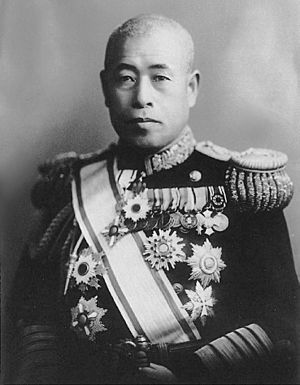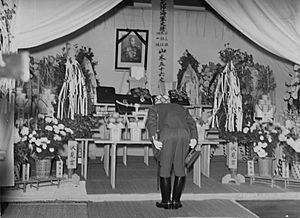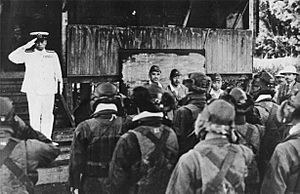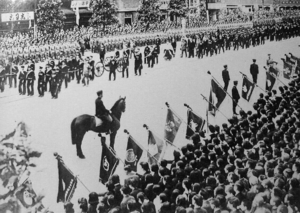Isoroku Yamamoto facts for kids
{Redirect|Admiral Yamamoto|Imperial Japanese Navy Minister who was in office from 1898–1906 and the 8th Prime Minister of Japan|Yamamoto Gonnohyōe}}
Quick facts for kids
Isoroku Yamamoto
|
|
|---|---|

Admiral Yamamoto (circa 1940)
|
|
| Native name |
山本 五十六
|
| Born | April 4, 1884 Nagaoka, Niigata, Empire of Japan |
| Died | April 18, 1943 (aged 59) near Panguna, Bougainville, Territory of New Guinea |
| Buried |
Tama Cemetery, Tokyo
|
| Allegiance | |
| Service/ |
|
| Years of service | 1904–1943 |
| Rank | |
| Commands held | Isuzu, Akagi, 1st Carrier Division, Naval Aviation Bureau, 1st Fleet, Combined Fleet, 1st Battleship Division |
| Battles/wars |
|
| Awards |
|
| Alma mater | Harvard University (1919–1921) Imperial Japanese Naval Academy (1901–1904) |
| Spouse(s) |
Reiko Mihashi
(m. 1918) |
| Other work | Vice-Minister of the Navy |
Isoroku Yamamoto (山本 五十六, Yamamoto Isoroku, April 4, 1884 – April 18, 1943) was a Japanese Marshal Admiral of the Imperial Japanese Navy (IJN) and the commander-in-chief of the Combined Fleet during World War II until he was killed.
Yamamoto held several important posts in the IJN, and undertook many of its changes and reorganizations, especially its development of naval aviation. He was the commander-in-chief during the early years of the Pacific War and oversaw major engagements including the attack on Pearl Harbor and the Battle of Midway.
Yamamoto was killed in April 1943 after American code breakers identified his flight plans, enabling the United States Army Air Forces to shoot down his plane. His death was a major blow to Japanese military morale during World War II.
Contents
Family background
Yamamoto was born Isoroku Takano (高野 五十六, Takano Isoroku) in Nagaoka, Niigata. His father, Sadayoshi Takano (高野 貞吉), was an intermediate-rank samurai of the Nagaoka Domain. "Isoroku" is an old Japanese term meaning "56"; the name referred to his father's age at Isoroku's birth.
In 1916, Isoroku was adopted into the Yamamoto family (another family of former Nagaoka samurai) and took the Yamamoto name. It was a common practice for samurai families lacking sons to adopt suitable young men in this fashion to carry on the family name, the rank and the income that went with it. Isoroku married Reiko Mihashi in 1918; they had two sons and two daughters.
Death

To boost morale following the defeat at Guadalcanal, Yamamoto decided to make an inspection tour throughout the South Pacific. It was during this tour that U.S. officials commenced an operation to kill him. On April 14, 1943, the United States naval intelligence effort, codenamed "Magic", intercepted and decrypted a message containing specifics of Yamamoto's tour, including arrival and departure times and locations, as well as the number and types of aircraft that would transport and accompany him on the journey. Yamamoto, the itinerary revealed, would be flying from Rabaul to Balalae Airfield, on an island near Bougainville in the Solomon Islands, on the morning of April 18, 1943.
President Franklin D. Roosevelt may have authorized Secretary of the Navy Frank Knox to "get Yamamoto," but no official record of such an order exists, and sources disagree whether he did so. Knox essentially let Admiral Chester W. Nimitz make the decision. Nimitz first consulted Admiral William Halsey Jr., Commander, South Pacific, and then authorized the mission on April 17 to intercept and shoot down Yamamoto's flight en route. A squadron of United States Army Air Forces Lockheed P-38 Lightning aircraft were assigned the task as only they possessed sufficient range. Select pilots from three units were informed that they were intercepting an "important high officer", with no specific name given.
On the morning of April 18, despite urging by local commanders to cancel the trip for fear of ambush, Yamamoto's two Mitsubishi G4M bombers, used as fast transport aircraft without bombs, left Rabaul as scheduled for the 315 mi (507 km) trip. Sixteen P-38s intercepted the flight over Bougainville, and a dogfight ensued between them and the six escorting Mitsubishi A6M Zeroes. First Lieutenant Rex T. Barber engaged the first of the two Japanese transports, which turned out to be T1-323 (Yamamoto's aircraft). He fired on the aircraft until it began to spew smoke from its left engine. Barber turned away to attack the other transport as Yamamoto's plane crashed into the jungle.
Yamamoto's staff cremated his remains at Buin, Papua New Guinea, and his ashes were returned to Tokyo aboard the battleship Musashi, his last flagship. He was given a full state funeral on June 5, 1943, where he received, posthumously, the title of Marshal Admiral and was awarded the Order of the Chrysanthemum (1st Class). He was also awarded Nazi Germany's Knight's Cross of the Iron Cross with Oak Leaves and Swords. Some of his ashes were buried in the public Tama Cemetery, Tokyo (多摩霊園) and the remainder at his ancestral burial grounds at the temple of Chuko-ji in Nagaoka City. He was succeeded as commander-in-chief of the Combined Fleet by Admiral Mineichi Koga.
In popular culture
Since the end of the Second World War, a number of Japanese and American films have depicted the character of Isoroku Yamamoto.
One of the most notable films is the 1970 movie Tora! Tora! Tora!, which stars Japanese actor Sô Yamamura as Yamamoto, who states after the attack on Pearl Harbor.
See also
 In Spanish: Isoroku Yamamoto para niños
In Spanish: Isoroku Yamamoto para niños



